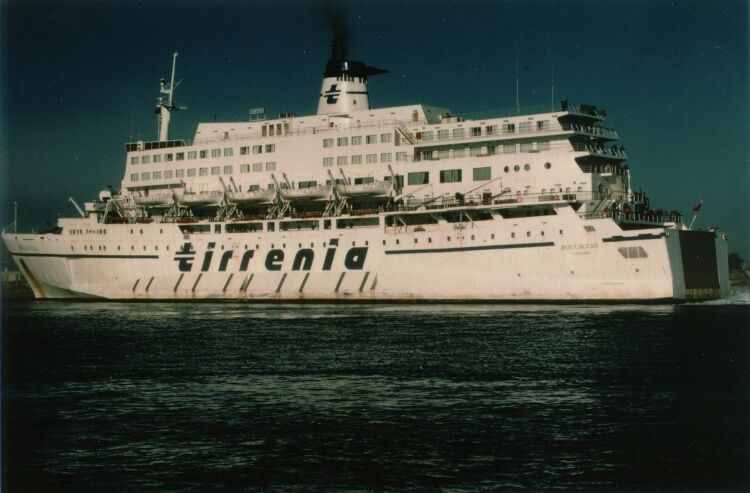
The “Boccaccio” in 1970
The Al Salam Boccaccio 98 was originally built as the 6,450 GRT Roll On/Roll Off (RO/RO) PAX/Ferry Boccaccio, one of 8 Poeta (Poet) class ships built by Italcantiere S.p.A., (Yard No. 4237), Monfalcone, Italy, for Tirrenia di Navigazione, Italy.
Launched 08 June 1969 and delivered 30 June 1970, she was 131.1 meters in length overall, 20 meters in beam, and 5.57 meters in draught. Propulsion was provided by two 9-cylinder Fiat S.G.M. diesel engines to twin shafts for a maximum speed of 22 knots. Passenger and vehicle carrying capacities at the time of delivery was listed as 500 passengers and 200 automobiles. The were also 506 passenger/crew staterooms.
Between June 1970 until 1991 the ship provided ferry services between Italy and Tunisia. In 1991 the ship was modified at INMA (INDUSTRIE NAVALI MECCANICHE AFFINI), La Spezia, Italy, with two additional upper decks being added and the car deck widened. These modifications increased the passenger/vehicle carrying capacities to 1,300 passengers and 320 vehicles. With 415 additional staterooms being added as well. This also increased the ship’s overall tonnage from 6,450 GRT to 11,799 GRT and increased the ship’s overall draft to 5.9 meters.
Upon completion of these modifications/upgrades, I have been unable to locate any of the ship’s service history until the ship was laid up in 1997.
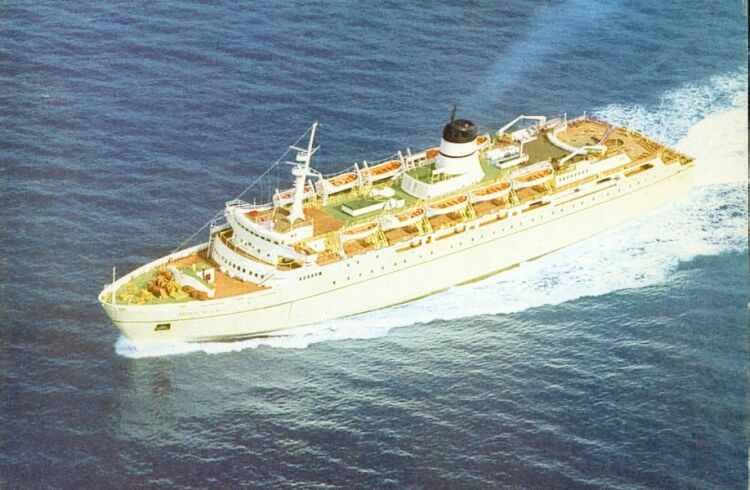
The “Boccaccio” in 1970
In January 1999 the ship was sold to the EL Salam Shipping Company, Suez, Egypt, renamed Al Salam Boccaccio 98, registered under the Panamanian flag at Pacific Sunlight Marine Inc., Panama, for service in the Red Sea.
From 25 July 2001 to 04 August 2001, the “Al Salam 98” was chartered to Tunisienne de Navigation S.A. (COTUNAV), Tunisia, for service between Genoa and Tunisia.
On 26 June 2002 the ship was chartered to Marini Travels, Bergamo, Italy, for service between Savona and Tangiers where the she encountered problems with Moroccan port authorities due to Marini Travels being considered competition with the state-owned COMUNAV which had started its own Genoa-Tangier service route in the same month.
From 18 June 2004 until 14 December of the same year, the “Al Salam 98” was chartered to the First Beirut Line/OTLS providing service between Beirut and Ancona, Turkey. Unfortunately, First Beirut Line/OTLS went bankrupt at the end of 2004.
In 2005, the Al Salam Boccaccio 98 arrived in the Red Sea where she provided ferry service between Duba, Saudi Arabia and Safaga, Egypt.
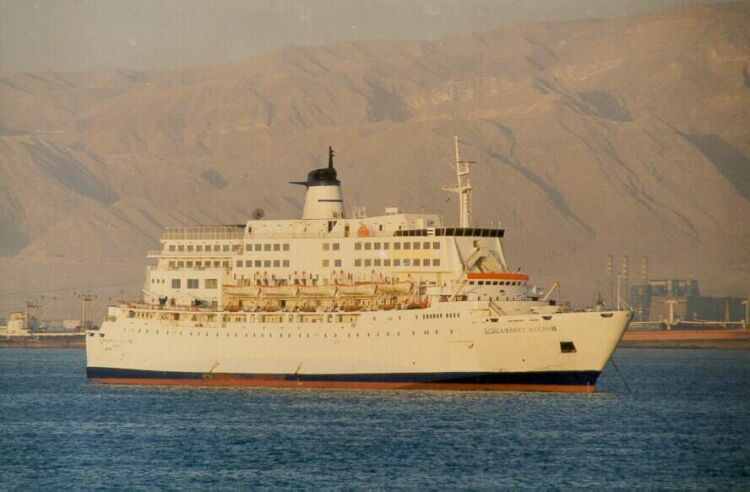
The “Al Salam Boccaccio 98” in the Red Sea
The Loss of the Al Salam Boccaccio 98On 02 February 2006, the ship departed Duba, Saudi Arabia, enroute to Safaga, Egypt, carrying 1,310-1,312 passengers, 96-104 crewmembers, and approximately 220 vehicles. (Note: different sources provide conflicting numbers on passenger and crew onboard.) The majority of the passengers were believed to have been Egyptians who worked in Saudi Arabia, as well as a number of other Egyptians returning from the Hajj in Mecca.
Shortly after departing Duba, survivor accounts indicated that a fire broke out either in the engine room or a storage area below decks. As the ship’s crew fought the fire, the fire-fighting water may have accumulated in the lower parts of the ship, including the car deck area. Some survivor accounts indicate that the ship had a list on it shortly after leaving port and, after several hours the list gradually became more pronounced. At no time did the ship send an SOS signal indicating that it was in trouble.Weather conditions at the time consisted of high winds of possibly up to 24 knots and one weather report from the MV Glasgow Maersk, which was approximately 150 kilmeters north of the “Al Salam 98” indicated that maximum wave height was 45 cm, with water temperature being 25-degrees (C).
The ship’s captain, Captain Sayed Ahmed Sayed Omar, had attempted to effect a 180-degree turn between 60 and 80-kilometers from the ship’s intended destination of Safaga. The ship capsized during the turn and sank in less than 10 minutes in over 900-meters of water.On 02 Febrary 2006 at 2358 UTC, an automated distress signal was received at the Air-Sea Control Room at RAF Kinloss, Scotland. The signal was relayed automatically via satellite from the ship. This distress alert was relayed, via France, to the Egyptian Authorities. However, it would be almost 12-hours before any rescue attempt would get underway! According to Mohamed Gad-EL-Hak, in his book “Large Scale Disaster“: Many officials failed to react promptly because an “important” soccer game was being televised”.
Once rescue efforts commenced, 4 Egyptian frigates and other rescue boats searched the area. The British government redirected the HMS Bulwark to the area, but the ship was a day and a half away. The Egyptian government declined assistance from the Israeli government, and eventually accepted the use of a P-3 Orien aircraft from the U.S. government after having initially declined the assistance.Of the over 1,400 passengers and crew onboard, almost 400 were reported rescued. The number of bodies recovered was reported on 03 February 2006 as being 185. Information concerning additional recovery of bodies is vague after this date.
Controversy after the Sinking:Controversy concerning this ship sinking started almost immediately after the first survivors were rescued:
– There were survivor reports stating that the captain, and some of the crew, were the first ones to depart the sinking ship. Although the captain is listed as being among those that lost their lives.
– The delay between the ship’s sinking and the commencement of rescue efforts.
– Transcripts from the ship’s recovered Voyage Data Recorder (VDR) showed that the ship’s owner had been informed about the fire onboard and directed the Captain not to return to port, but to continue on to Safaga.
– No SOS signal was sent by the Captain of the ship prior to the sinking.
– Questions arose concerning the ship’s certifications and liscensing, and the ship not being able to operate in Mediterranean waters.
– Shortly after the sinking, the owner of the Al Salam Maritime Transport company, along with his son, fled the country.
– Ship’s crew reports that the fire-fighters aided in the sinking of the ship because the deck drains were clogged or the drainage pumps were in-operative.
– The Captain of the Saint Catherine steering clear of the Al Salam Boccaccio 98 and refusing to turn back to provide assistance to the ship. Reasons cited were that the ship was unable to turn back due to high winds and heavy seas. (The Saint Catherine is also owned by the Al Salam Maritime Transport Company.)
The Aftermath
The Voyage Data Recorder, a Broadgate VER3000 manufactured by SELEX Communications, was recovered 21 February 2006 and was returned to SELEX where the stored data was recovered and sent to a Board of Investigation for analysis. (The VDR is capable of storing up to 12-hours of data from shipboard navigation systems, electronic systems, communications and recordings of conversations held on the ship’s bridge.) Results of the analysis of the VDR indicated that, as quoted from “www.safety at sea.net”:”25 Apr 2006 A maritime safety expert has told Fairplay that conversations recorded on the bridge of the ferry Al Salam Boccaccio 98 just before it sank showed there was “little or no semblance of a working Safety Management System on board.” Dr Phil Anderson, managing director of ConsultISM in the UK, said evidence from the transcript painted a “stark and deeply distressing” picture. The evidence suggests that the master, officers and crew “had little or no idea how to respond to the most basic and fundamental ’emergency shipboard situation’ – ie a fire on board.” Dr Anderson added: “The indecision, lack of leadership, disorganised and unstructured response would suggest to me that there could not have been any meaningful or effective ‘drills or exercises’ carried out by the individuals involved on board that ship” as required under Section 8.2 of the ISM Code. The master’s delay in involving the ship’s operator, Cairo-based El Salam Maritime Transport, until it was too late suggested that the master did not recognise the option as being part of an emergency response plan.
The owner of the Al Salam Maritime Transport Company, Mamdouh Ismail, along with 5 other people were charged by the Egyptian government with manslaughter. The Egyptian Government then froze the assets of all 6 people and placed a travel ban on then. However, Ismail and his son were still allowed to leave the country. Mamdouh Ismail and his son eventually returned to Egypt to stand trial. Mamdouh Ismail’s personal assets were unfrozen after he agreed to pay $57 million to the families of the deceased. 5 of the 6 people charged with manslaughter were acquitted in July 2008. The only person convicted was required to pay a 10,000 L.E. fine ($1800). These acquittals raised additional questions concerning government corruption and cover-ups, as Mamdouh Ismail is also a member of the Egyptian Parliament. The acquittals and conviction are said to be on appeal as of December 2008.
The cause of the ship’s sinking has been contributed to a number of possible factors:
– Fire-fighting water accumulating on deck due to clogged deck drains and/or inoperative drainage pumps contributed to instability of the ship by “free surface effect”.
– Due to modifications to the ship’s structure in 1991, the ship was less stable than as originally designed (made more top-heavy).
– Lack of training in emergency response procedures by the ship’s Captain and crew.
– Vehicles in the car deck may have shifted, further degrading ship stability.
– High winds and heavy seas forced the already unstable ship to capsize while making its final turn.
On a Final Note:The Al Salam Maritime Transport company has had numerous ferry sinkings in the past. The
Salem Express struck a reef and sank on 22 December 1991 with the loss of 470 lives. The
Al Salam Petrarca 90, sister ship to the
al Salam Boccaccio 98, sank on 07 October 2001 with the loss of four lives. The Al Salam 95 caught fire and sank in June 2002 with the loss of 24 lives. And the
Pride of Al Salam was sunk in a collision with a Cypriot freighter and sank just outside of Suez October 2005 with the loss of one life.






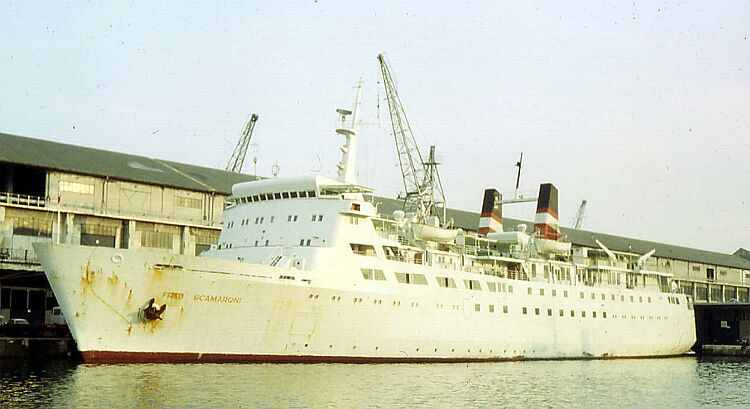
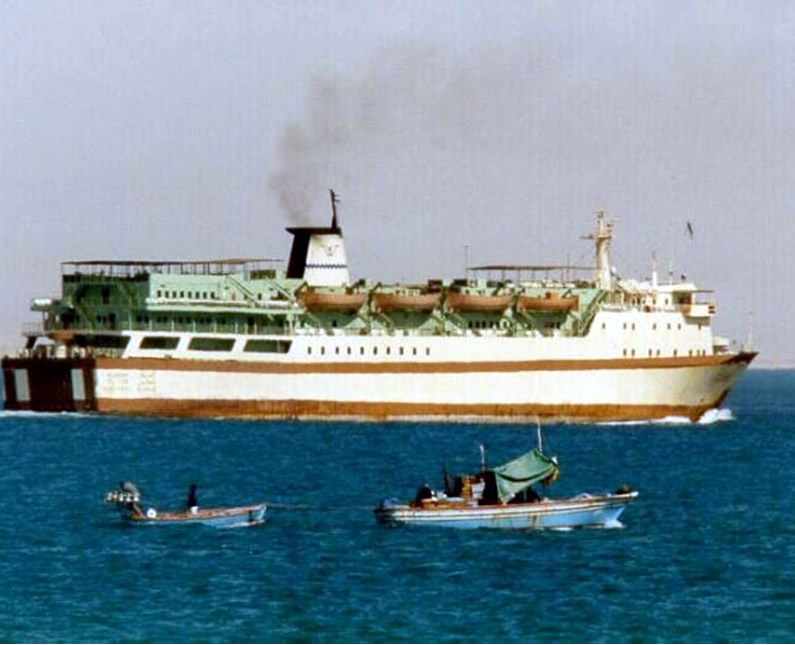
![[GALLERY] Top 5 Wrecks At The Red Sea Wreck Project SS Thistlegorm](https://www.redseawreckproject.com/wp-content/uploads/sites/21/2013/08/thistlegorm2.jpg)
5 Comments
Pingback: Top Ten Lesser-Known Tragic Disasters – YourWorlds
Pingback: Top Ten Lesser-Known Tragic Disasters - Listverse
Pingback: Az Bilinen İlk On Trajik Felaket - En İyi 10 Liste
Pingback: Top Ten Lesser-Known Tragic Disasters – Prevailing News
Pingback: Top Ten Lesser-Known Tragic Disasters – Top 10 Celeb